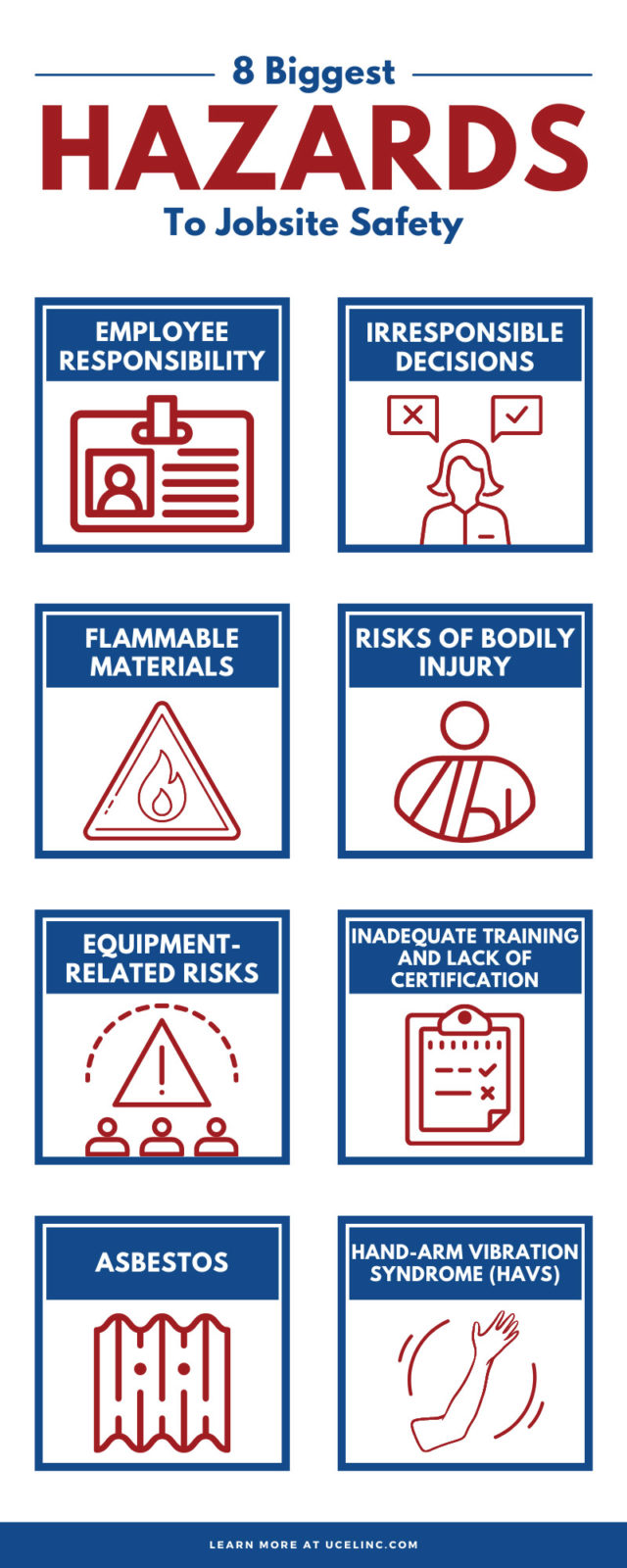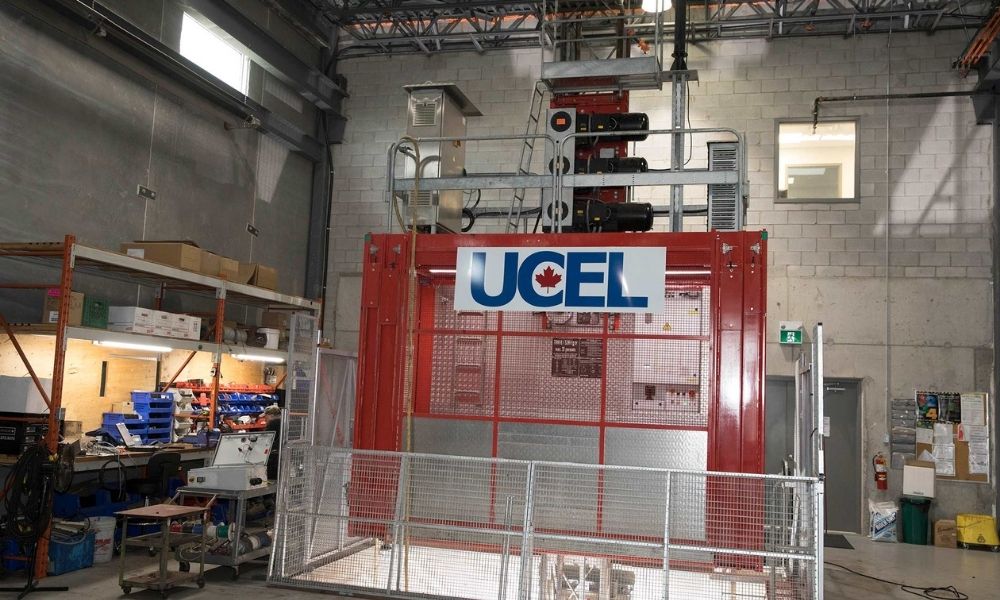Electrocution, slips, trips, and falls, malfunctioning or improper use of heavy machinery. According to statistics, there are more than 100,000 reported construction-related accidents each year. Thankfully, these numbers have fallen dramatically since employers started taking workers’ safety seriously.
One may think that all employers always prioritized the safety of their workers. But the shocking truth is that employee safety wasn’t a concern for employers until the early 1970s. In 1970, the Occupational Health and Safety Act was passed, followed closely by the formation of the Occupational Health and Safety Association in 1971. Fall protection was one of the first concerns addressed by OSHA.
Before that time, workers were responsible for their own safety on the construction site. That leads us to our first of eight biggest hazards to jobsite safety.
Employee Responsibility
Before the early 1970s, a construction worker’s safety was in their own hands. They had to deal with a combination of hazardous tasks, lack of training, and minimal to no protective gear. Construction workers faced an incredible amount of danger each day.
Once OSHA was formed and began to collect data from workers, employers began to take fall protection and other safety hazards seriously. This led to a sharp focus on safety in the workplace, and a reduction in falls and other dangers.
Irresponsible Decisions
Responsible decisions in both the planning and design stages of a construction project can ensure safety for workers. On the other hand, irresponsible decision-making can result in occupational hazards and increased risk for injury or property damage.
Irresponsible decisions include:
- Poor planning in relation to weather
- Poor cooperation between various parties on the jobsite
- Poor communication between owners, inspectors, management, and crew
- Minimal or no training on certain machinery, worksites, or scenarios
Flammable Materials
Flammable materials and chemicals may be found on the worksite, and their presence can lead to serious safety hazards. Workers who skirt around the no-smoking rule, individuals who aren’t trained in handling flammable materials or chemicals, and the occasional accident may unintentionally cause a fire or explosion.
Risks of Bodily Injury
There are lots of serious personal safety risks on a construction site. Even with the proper personal protective gear, adequate training, and astute awareness, the occasional hazard presents itself. Some of the most common accidents that lead to serious risk of bodily injury are
- Falls due to insufficient, improperly used, or damaged fall protection
- Electrical hazards, including shock and arc flash
- Being caught between or crushed by equipment or objects
- Being struck by equipment or an object
- Improper use of scaffolding
- Improper use of ladders
- Insufficient eye and face protection
- Insufficient respiratory protection
- Insufficient communication
- Improper use or failure of heavy equipment
- Insufficient guarding of heavy equipment
- Insufficient ear protection
Equipment-Related Risks
As listed above, many jobsite hazards are related to the improper use of heavy machinery and equipment. The vast majority of workplace hazards occur with
- Improper use of power tools
- Accidents related to heavy machinery such as cranes, excavators, and bulldozers
In addition to the safety risks posed by heavy machinery, construction companies also have many other risks. When a piece of equipment misses an inspection—and therefore misses an opportunity to replace failing or damaged parts—or is used improperly, the entire project can be put on hold. There may be a need for costly repairs or replacements. It can also take a significant amount of time for those repairs to be done or replacements to come in. In addition, there may be extensive property damage that needs tending to. There may even be lawsuits, which is a further financial hazard for companies.
Additionally, workers tend to lose their productivity when important equipment is down or when an accident happens. It’s difficult to work when you don’t have the machinery you need, or when a coworker is seriously injured.
In our world of construction hoists, equipment can pose major risks if it’s handled by untrained, careless, or unwell personnel. There have been lethal accidents in Florida, Texas, California, Massachusetts, and many other states working on construction hoists. The most common lethal injury in construction hoisting occurs when an inattentive or unwell employee does not install the construction hoists’ tower bolts, or tie-in bolts correctly, causing a fatal toppling of the machinery.
Inadequate Training and Lack of Certification
One major hazard presented on any jobsite is lack of training. When employees aren’t trained enough—or at all—about the equipment they’ll use or situations they’ll face, serious safety hazards arise. Employees that operate machinery when they’re uncertified to do so pose a serious safety risk to themselves and their coworkers. Equipment makers such as cranes, excavators, and construction hoist manufacturers provide rules for operating their machinery. Sometimes, they offer training classes as well.
In addition to posing a safety risk, individuals that operate machinery they aren’t trained, certified, or licensed to use could cost the construction company a significant amount of money in damages and potentially lawsuits since accidents are at the fault of the company.
A lack of overall safety training is another jobsite hazard. For example, most construction companies offer safety training when crew members first start their jobs. But then they never train again.
Sadly, in many areas throughout the United States, local jurisdictions don’t have any formal licensing or certification to work on construction hoists or transport platforms. Some states are exceptions, such as Massachusetts, where trained elevator mechanics must be present on construction hoist projects. Many states rely on “employer-deemed-competency” and easy-to-achieve manufacturer’s certifications. In Canada, the situation is similar in the prairie provinces like Alberta and Saskatchewan but is very stringent in provinces like Ontario and British Columbia. There, multi-year apprenticeship programs in schools include rigorous oversight, examinations, ongoing training, and months-long theoretical training.
Asbestos
While asbestos is not often present in new construction projects, it’s plentiful in demolitions and renovations. Construction workers face significant risk when they inhale asbestos after manipulating or breaking materials that contain it. While asbestos doesn’t cause immediate, visible bodily harm like a fall or shock would, it can cause serious and potentially fatal diseases such as lung cancer and asbestosis.
Hand-Arm Vibration Syndrome (HAVS)
While it’s preventable, this syndrome is painful and incapacitating. Hand-Arm Vibration Syndrome affects a person’s blood vessels, nerves, and joints. Construction workers develop this disease by the continual use of hand-held power tools such as power drills. Vibrating ground working equipment such as breakers, hammers, and core drills can also be culprits.
When a worker is affected by HAVS, their ability to perform their jobs on the construction site is impaired. Workers experience an inability to execute detailed jobs and extreme pain in their fingers when it’s cold outside. Companies can prevent employees from developing HAVS by ensuring that crew members have sufficient protection and that all equipment is well-maintained.
UCEL Inc. takes safety extremely seriously. Our carefully vetted construction hoist manufacturing partner is an ISO 9001 quality management certified company, is UL/c-UL certified, and meets the highest CSA (Canada), ANSI (US), and TUV (European) requirements. Our on-site training facility and seminars held several times a year ensure that every worker wearing a UCEL badge knows exactly what they’re doing with the utmost safety.

